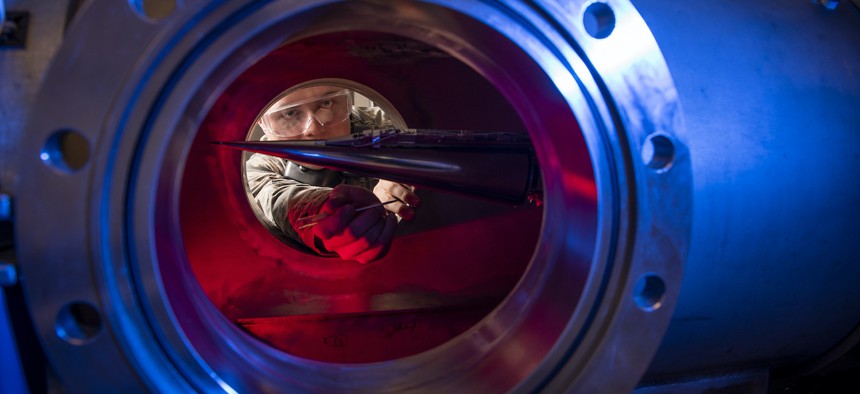
In this 2019 photo, a U.S. Air Force Academy cadet conducts hypersonic research. U.S. Air Force Academy / Joshua Armstrong
US should accelerate hypersonic defenses, NORTHCOM head says
“We can’t pause at all,” Gen. Gregory Guillot told Congress.
The U.S. should act quickly on developing hypersonic defenses, to stay ahead of “the consistently growing capabilities of our adversaries,” the head of U.S. Northern Command and NORAD told lawmakers Thursday.
Gen. Gregory Guillot and other officials testified this week about the rapid pace of China and Russia’s work in highly maneuverable hypersonics, just days after the Pentagon submitted a budget request that would cut funding for one of the programs to defend against such missiles.
Guillot did not comment directly on the proposed cut, but he told Congress he supports moving the development of those defensive capabilities “as far left as possible”—i.e., speeding it up.
Earlier in the week, a broad group of missile defense officials outlined the speed of China and Russia’s hypersonic development to the House Armed Services Committee.
“China has demonstrated a high pace of flight testing for its hypersonic systems. This emphasis is enabling China to deploy weapons, including the DF-17 that has an estimated range of at least 1,600 kilometers, enabling it to reach U.S. military bases and fleet assets in the western Pacific. Since 2014, China has conducted several tests in pursuit of an intercontinental range hypersonic glide vehicle,” Jeff McCormick, a senior intelligence analyst at the National Air and Space Intelligence Center, told lawmakers.
A hypersonic glide vehicle is one of two types of highly maneuverable hypersonic missiles that rises to a high altitude and then uses gravity to go as fast as five times the speed of sound, but unlike a regular ballistic missile, it also uses advanced propulsion to achieve an unpredictable path to the target, making it very difficult to intercept.
The Missile Defense Agency is working on an interceptor for glide-phase hypersonic weapons, but the fiscal 2025 budget request released this week trims the program from $209 million in the FY 2024 request to $182 million. Sen. Deb Fischer, R-NE, said Thursday that the Missile Defense Agency has pushed delivery of an interceptor until 2035. But last year’s National Defense Authorization Act “requires the Missile Defense Agency to achieve an initial operational capability of that program by December 31, 2029,” she said.
Guillot is pleased with “some” of the efforts MDA is undertaking to adapt conventional missiles like the SM-6 to possibly intercept hypersonics, as well as efforts to deploy hypersonic missile-tracking satellites. But “my response is that I view hypersonics as perhaps the most destabilizing threat that we have out there, because of the fast speed and more than that, the maneuverability and the unpredictability on where it will impact as opposed to a ballistic missile, which is fairly predictable,” he said.
And that’s hardly the only missile threat NORTHCOM is facing. Guilliot said that while NORTHCOM had been making some key improvements in defenses against various types of more conventional missile threats, mostly by adjusting radar settings, “We’re right on the edge… we can’t pause at all. The adversaries are growing” their capabilities.
NEXT STORY: The big AI research DARPA is funding this year
